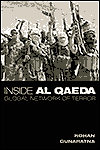|
| Home | About Kashmir Herald | |
Volume 2, No. 9 - February 2003 |
|
| Featured Article |
|
|
|
Wahi: The Supernatural Basis of Islam Part V -
Dr. Somers’ diagnosis of Mohammed (1) [Editor's Note: Kashmir Herald is honored to have Dr. Koenraad ELST write a series of articles exclusively for Kashmir Herald. His series of 5 exclusive articles on "The Supernatural Basis of Islam" will be published exclusively here on Kashmir Herald.] Ever since Mohammed’s first preachings, people have tried to pinpoint the psychic ailment accounting for his prophetic self-delusion. Thus, some Christian polemicists described him as an epileptic, citing episodes in which he foamed at the mouth and rolled on the floor. This was a meritorious guess, but its explanatory power was limited because the neurological disorder of epilepsy need not be accompanied by hallucinations and an enduring self-delusion. However, now that psychopathology has matured into a scientific discipline, a more accurate diagnosis is available. The Flemish psychologist, Dr. Herman Somers, formerly a Jesuit who became a religious skeptic after discovering psychopathological elements in the utterances of some Biblical prophets, has elaborated the first technical diagnosis of Mohammed’s behaviour. So far, it is only available in Dutch: Een andere Mohammed (“A different Mohammed”, Hadewych, Antwerp 1993), but I will give its outline in English. The basis of this diagnosis is the elaborate description of Mohammed’s personality and conduct provided by the Quran and by the Hadith (traditions of the prophet, grouped by theme) and Sira (chronological biography) literature. As for the nature of these sources, it is worth noting the contrast between Jesus and Mohammed. Jesus is a composite literary character made up of reports on a historical wandering healer-preacher combined with religious stereotypes, partly borrowed from other traditions, and with deliberate interpolations made by the evangelists in compliance with the developing political and theological needs of the budding Church. Mohammed, on the other hand, is a fully historical character. To be sure, we are aware of unconventional theories questioning the historicity of the entire Mohammed narrative including the Quran (vide e.g. Ibn Warraq: The Origins of the Koran, Prometheus, New York 1998). If these were to be accepted, Islam is in very deep trouble, for the whole edifice of Islamic belief and jurisprudence is based on the assumption of the historicity of the traditions concerning Mohammed. It is not our duty to save Islam from these skeptics, but we think they are going too far. One of the reasons why the tradition should be given the benefit of the doubt is that it contains too many admissions against interest, accounts of less than flattering data about Mohammed and his companions (even about Mohammed being derided as a madman), clearly included because they happened to be known as factual and not because they served anyone’s political or hagiographical interests. Another reason is that there is simply no motive for inventing most of it. In the case of certain political rules laid down by the Prophet, one could still assume strong motives on the part of later contenders for leadership to attribute this or that position to the Prophet,-- though in that case, it is strange that he was allowed to remain silent on so many contentious issues, e.g. that before his death, he wasn’t made to speak out on the question of how his succession was to proceed (a matter leading to a civil war, the murder of caliph Ali and his son Hussein, and the Shiite schism). But the tradition contains many uncontroversial judgments and regulations and plenty of humdrum information devoid of implications for later inter-Muslim power struggles or theological system-building; it is unlikely that this was all interpolated. This is especially true when it comes to the description of the Prophet: the Ummayad- or Abbasid-age traditionists had nothing to gain from describing Mohammed’s complexion, hygienic habits, sex life etc. with the information they gave rather than with any other. Even if a lot has been added to or changed in the historical data during the editing of the core Islamic text corpus, many correct data must have been preserved. In particular, if the tradition describes a pathological syndrome entirely in conformity with modern medical knowledge unavailable to the authors, it is clear that the latter cannot have invented the description but must have been describing a real case to which they or their informants had been witnesses. Dr. Somers explains: “The reader be warned against a strange type of reasoning by certain doctores, whether historians or medics. They assume that the preserved traditions have been written down belatedly, that they are hard to control, and that some clearly belong to mythology. Preparing a diagnosis on the basis of such uncertain data is clearly nonsense. (…) They forget that they are proceeding from an unproven and dubious supposition, viz. that all data in the sources are untrue and unreliable. (…) First of all, the tradition undeniably preserves a number of more or less reliable data. Secondly, modern science disposes of detailed information about all kinds of diseases. These information elements are called symptoms; they are bundled into syndromes. (…) What we now find, to our amazement, is that the facts passed on to us by the tradition correspond with the symptoms and syndromes known to modern science. Now, if these traditions describe the facts with such exactitude, they must be reliable.” (p.18) It is one thing if someone makes a general claim that Mister X is “mad” (as in jokes about a stereotypical madcap’s hilarious behaviour), but quite another when he describes in detail the typical development of the paranoia syndrome. In the latter case, either he is a student of modern psychopathology quoting a textbook description, or he is describing an actual case to which he was a witness. Mohammed, according to Dr. Somers, was a classic case of paranoia. The syndrome of paranoia is essentially characterized by a delusion about oneself nourished by recurring hallucinations. These hallucinations may be auditory (hearing voices), visual (seeing visions or apparitions), or purely mental (being struck with sudden “insights” of enormous and unshakable certainty, unsusceptible to falsification by reality). The delusion typically puts the affected person in the centre of events: either he is the target of a ubiquitous and all-powerful conspiracy (delusion of persecution); or he is the privileged witness to a cosmic event, esp. the imminent end of the world; or he has been selected for a unique mission. Mohammed’s life-story offers only a hint at a delusion of persecution. He (and later his apologists) liked to see himself as persecuted by the Meccans, which is usually given as the reason for his migration to Yathrib/Medina. While this might have been true, the reality of his interaction with the Meccans after his migration suggests otherwise: a few months later, he lets his followers invite their families from Mecca to join them in Medina. However, if the Meccans had really been serious about confronting and “persecuting” Mohammed, it is unlikely that they would have allowed these relatives to leave, as they made perfect hostages of great strategic value in a grim confrontation. The delusion of being privy to esoteric information about the approaching end of the world (though not about its exact timing, a prediction that would have been uncomfortably testable), also announced by some Biblical prophets, is much more pronounced. Q.15:85, 44:10/9 and 78:40 assure us that the end is nigh (as Jesus’ apostles had also been made to believe). The description of the Final Judgment is one of the main recurring themes of the Quran. While partly based on Mohammed’s hearsay knowledge of Jewish and Christian theology, it is charged with a strong personal involvement based on his deeply impressing visions of how the Judgment would arrive, what the fate of the different categories of men would be, and what the roles of major religious beings in it would be: that of Jesus, but also that of Mohammed himself. Mohammed’s central delusion, however, was his belief, first hesitant but soon becoming unshakable, that he had been selected for a unique mission of cosmic proportions. He is God’s spokesman, and not just one among many, but in his age the only spokesman, and for the remaining interval before Judgment Day also the final spokesman, the “Seal of the Prophets”. This unique mission forms the contents of his second “revelation” on that fateful day in the month of Ramadan, AD 610. In the first “revelation”, the archangel Gabriel had ordered him: “Read!” (or “Recite!”, or “Proclaim aloud!”, Arabic Iqra’, whence Qur’ân), and Mohammed had been left confused and incomprehending. Thinking that he was becoming “a man possessed”, he made up his mind to go and commit suicide, but then Gabriel appeared again, this time with a very clear message: “O Mohammed, thou art the apostle of God and I am Gabriel.” (Sira, Guillaume tra., p.106/153 ; Q.96:1) This self-delusion turned the businessman Mohammed into a prophet, then a cult leader for a small secret circle, next a prominent religious leader with political ambitions, and finally the first emperor of all Arabia and founder of a conquering world religion. It forms the core of the creed pronounced by all Muslims: “There is no God but God and Mohammed is God’s prophet.” Whereas monotheism, the belief in a single God, is espoused by several other religions beside Islam, the belief in Mohammed’s prophethood (which implies the belief in the divine origin of the Quran and hence the commitment to revere and obey the Quran) is the unique and defining doctrine of Islam. Sad to say, this world religion espoused by more than a billion contemporary human beings, is based on a delusion. [Click here for Part I] [Click here for Part II] [Click here for Part III] [Click here for Part IV] [Born in Leuven, in the year 1959, Koenraad Elst grew up in the Catholic Community in Belgium. He was active for some years in what is known as the new Age movement, before studying at the famed Catholic University of Leuven (KUL). He graduated in Chinese Studies, Indo-Iranian Studies and Philosophy. He earned his doctorate magna cum laude with a dissertation on the politics of Hindu Revivalism. He took courses in Indian philosophy at the Benares Hindu University (BHU), and interviewed many Indian leaders and thinkers during his stay in India between 1988 and 1992. He has published in Dutch about language policy issues, contemporary politics, history of science and Oriental philosophies; in English about the Ayodhya issue and about the general religio-political situation in India. A few of his latest books are:
While doing research in Indian philosophy at Benares Hindu University, he started taking an interest in the ongoing Rushdie and Ayodhya controversies and the larger debate on secularism. He published several books on the historical Ayodhya file. He is currently working as a free-lance scholar and columnist.] |
 |
 |
 |
|
|
Archives
| Privacy Policy |
Copyrights
|
Contact
Us | |
||